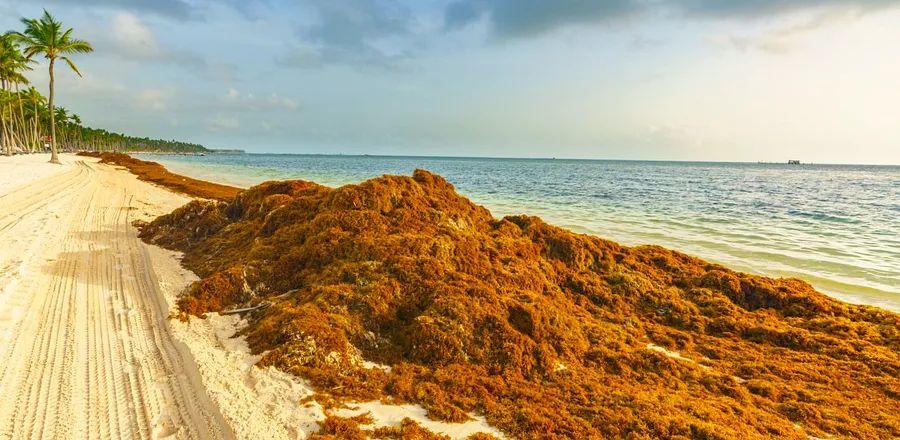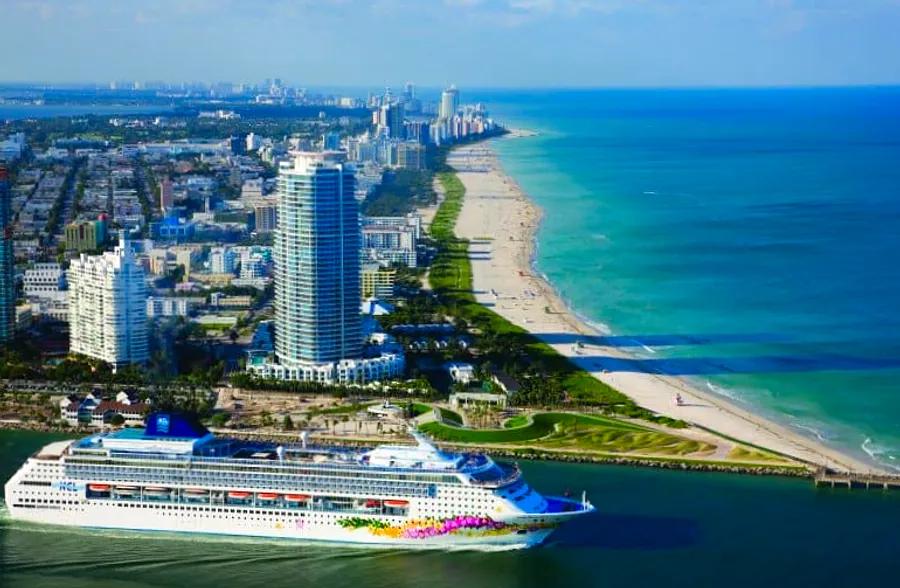What a Huge Sargassum Bloom Might Mean for Your Vacation in Florida, the Caribbean, or Mexico

A significant 'seaweed blob' from the Great Sargassum Belt is back in the news, raising concerns for beachgoers about potential vacations along the Gulf of Mexico and Atlantic Ocean being affected by layers of decaying, smelly algae.
Earlier this year, scientists from the University of South Florida shared data indicating that the seaweed in the Great Sargassum Belt—a 5,000-mile stretch of brown floating seaweed found between West Africa and the Gulf of Mexico—had doubled in size over two months (December 2022 and January 2023). However, a recent report at the end of May revealed a 15 percent decrease in the seaweed amount for May compared to April 2023.
The report mentioned, "The reasons for this sudden drop are still under investigation," noting that with the unexpected decrease in the eastern Atlantic and stable amounts elsewhere, predicting future sargassum levels in specific regions is challenging. Researchers anticipate that sargassum levels will remain "relatively high" this year compared to previous years.
To gain insights into what this rapidly expanding seaweed mass may imply for our favorite beach spots in the months ahead, we consulted with experts.
What is Sargassum?
If you’ve spent time on a beach along the Atlantic Ocean or Gulf of Mexico, you’ve likely encountered sargassum, even if just in small quantities along the shore or in the water.
This naturally occurring brown seaweed floats on the ocean’s surface and can extend as deep as 10 feet below, occasionally drifting ashore with the help of currents and winds.
"It’s a type of floating brown macroalgae, similar to kelp, but it always stays afloat, never anchoring to the ocean floor," says Brian Barnes, a marine science expert and assistant professor at the University of South Florida, which gathers data on sargassum blooms in the Caribbean Sea.
Sargassum consists of gas-filled structures resembling berries, known as pneumatocysts, which help it stay buoyant.
Visible from space, the Great Sargassum Belt making news lately is a massive 13-million-ton formation that stretches 5,000 miles in length and 300 miles in width, located in the Atlantic Ocean between the Gulf of Mexico and the coast of West Africa.
"When it’s offshore, it’s beneficial," explains Brian LaPointe, a research professor at Florida Atlantic University’s Harbor Branch Oceanographic Institute in Fort Pierce, Florida. "Sargassum provides essential habitat for hundreds of species and invertebrates, including endangered sea turtles, and supports pelagic fisheries like mahi mahi and other fish that prey on it." (Pelagic fish live and feed near the ocean’s surface.)
"It’s when it washes ashore in large quantities that it becomes problematic," LaPointe remarks about the seaweed.

Photo by Shutterstock
Is it safe to swim in water with sargassum?
Depending on its thickness, swimming in water where sargassum is present may require you to push it aside to create a path. Additionally, sargassum can feel rough against the skin, similar to a loofah sponge. (Dolphins have been known to interact with sargassum, sometimes using it to scratch themselves, according to the Wild Dolphin Project.) However, LaPointe warns that swimming in areas with a lot of sargassum can lead to some unpleasant experiences.
"You can swim in waters with sargassum, and many people do, but I've seen reports of sea lice in areas with large mats of it," he explains, referring to small jellyfish larvae that can cause red, itchy rashes on the skin.
LaPointe also cautions about potential stinging organisms, noting that jellyfish are often found among sargassum.
The smell of decomposing sargassum, reminiscent of rotten eggs due to hydrogen sulfide gas production, can be quite unpleasant. LaPointe adds that there have been cases of respiratory issues in areas with significant amounts of decaying sargassum along the shore because of the hydrogen sulfide released.
What’s behind the current surge in sargassum?
According to Barnes, researchers are actively investigating the reasons for the current abundance of sargassum. From his viewpoint, it primarily stems from ideal conditions for its growth.
"Like land plants, sargassum requires the right light and temperature conditions for optimal growth," he explains, noting that the existing population of sargassum in the Great Sargassum Belt serves as the 'seed' for new growth. Nutrients rising from ocean depths or flowing in from rivers act like fertilizers, enhancing these favorable conditions.
LaPointe emphasizes that the scale of the current bloom is largely attributed to nutrient availability.
"The more nutrients it receives, the larger it grows," he states, pointing out evidence that nutrient runoff—particularly nitrogen and phosphorus from human activities like fertilizers, wastewater, vehicle emissions, and animal waste—originating from rivers such as the Mississippi, Amazon, and Congo, is nourishing sargassum blooms throughout the Atlantic Basin.
Which beaches and destinations are most likely to be impacted by the expanding sargassum belt?
"We’ve seen significant blooms before," Barnes notes, referencing record levels in 2018 and 2022. However, he points out that there were no major blooms prior to 2011, and the reasons for this remain unclear.
According to him, all Caribbean islands fall within the range of areas where sargassum could wash ashore, with the Southern Lesser Antilles (including Aruba, Bonaire, Curaçao, Margarita Island, and Trinidad and Tobago) expected to experience slightly less impact compared to other parts of the Caribbean. "But that doesn’t mean they will be unaffected," he adds regarding these locations.
Other regions at risk within the sargassum belt include the Yucatan (on the Gulf of Mexico coasts of Belize and Mexico), the Gulf of Mexico (stretching from Florida’s panhandle to Texas), and southeast Florida, from the Florida Keys northwest to around Fort Pierce, according to Barnes.
"While Florida has faced significant challenges in the past, the sargassum issue is generally more pronounced in the Caribbean than in Florida," he explains. "This has been the case this year and in previous years as well." The reason the Caribbean experiences a greater problem is due to currents that bring in larger quantities of sargassum and keep it circulating for extended periods.
"While we can’t foresee what will occur this summer, historically, Mexico and the eastern Caribbean—areas like Barbados and Martinique—have experienced significant impacts," LaPointe states.
LaPointe emphasizes that the accumulation of sargassum is quite unpredictable.
"Strong winds can bring it in one day, creating large piles, and the next day, a shift in wind and currents can push it back offshore," he explains.
What can destinations and beachfront hotels and resorts do to alleviate the issue?
Preventing sargassum from washing onto a beach can feel like trying to hold back a rising tide. Unfortunately, it has become commonplace to see workers tirelessly pitchforking and shoveling seaweed into wheelbarrows around the clock at popular beach destinations like Playa del Carmen and Tulum in Mexico, as well as Barbados in the Caribbean.
In addition to clearing away the sargassum that washes ashore, Barnes suggests that hotels might install a floating boom offshore (typically made of PVC and aligned parallel to the shoreline) to help keep sargassum at bay. However, he cautions that this is just a minor measure against a massive challenge.
He notes that booms are not entirely effective and can only cover relatively small areas within the context of the larger bloom. Since booms can’t be infinitely long, sargassum can still infiltrate from their ends and reach the beach.
"They are helpful, but not flawless," Barnes admits.
Nonetheless, one place that’s likely to remain perfect on a sunny day, regardless of the Great Sargassum Belt or shifting ocean currents and winds? Your hotel pool, especially if it offers ocean views.
After all, having a backup plan for a beach day is always a good idea.
This article was first published on March 24, 2023, and has been revised to reflect the latest information.
Evaluation :
5/5



